SEO writing is the process of researching, outlining, creating, and optimizing content to rank for a target keyword in Google and other search engines.
Google’s success depends on delivering content that answers people’s queries in the most relevant way possible. If you want it to be your content that people see, ‘sprinkling on some SEO’ as an afterthought won’t take you far. Instead, you need to bake SEO into your content writing process right from the start.
This guide covers:
- Why SEO writing matters
- How to write for SEO: a 5‑step approach
- 5 SEO writing tips
There’s a lot of content out there that never gets seen because it doesn’t rank, and therefore it never gets the chance to educate, help, impress, and convert anyone (plus, it fails to reflect positively on you, the person who wrote it).
In contrast, writing with SEO in mind helps you earn organic traffic and bring qualified readers and potential customers to your website.
For example, the Ahrefs team spent the last 5 years growing the blog from ~5,000 to ~555,000 organic monthly visits. This content ranks and drives targeted traffic to the site, where potential customers can learn about using Ahrefs to grow their traffic and business. Eventually, some of them will take action by signing up.
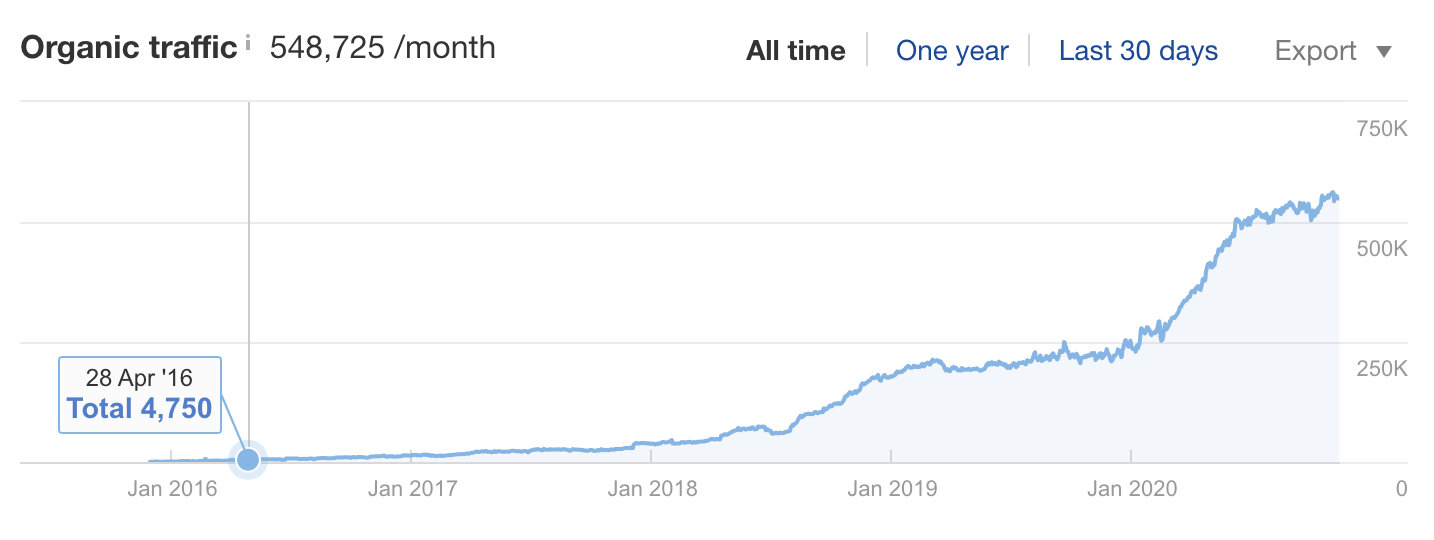
Traffic growth to the Ahrefs Blog. Data from Ahrefs’ Site Explorer.
SEO writing is about researching and writing content that ranks in search engines, but this doesn’t mean you’ll be writing artificially for an audience of robots. Your main goal is understanding what people are looking for so you can align your content with their needs.
Here’s a 5‑step, beginner-friendly framework to help you write a blog post or article with SEO in mind. For each step, I added examples from the guide you’re currently reading so you get to see how the research and writing process unfolds behind the scenes.
- Find a business-relevant keyword with traffic potential
- Determine search intent
- Determine the subtopics you need to cover
- Create an outline
- Write your piece
PS: you’ll notice that writing is just the last step—that’s the thing when you write for SEO: to do a great job, you first need to put your researcher hat on and investigate what people are looking for, what they expect to find, and what you’ll need to write as a result. Only then can the writing begin.
1. Find a business-relevant keyword with traffic potential
Begin by identifying a topic that’s relevant to the business you’re writing for. Think of what people might type into Google to find your product or service: this is your seed keyword.
For example, if you write for a business that sells lamps, your seed keyword could simply be “lamp” or “lamps.”
Start your research by adding the seed keyword into Ahrefs’ Keyword Explorer and use the Questions report to find keyword ideas phrased as questions. Most of the results will be informational queries that you can rank a blog post for.
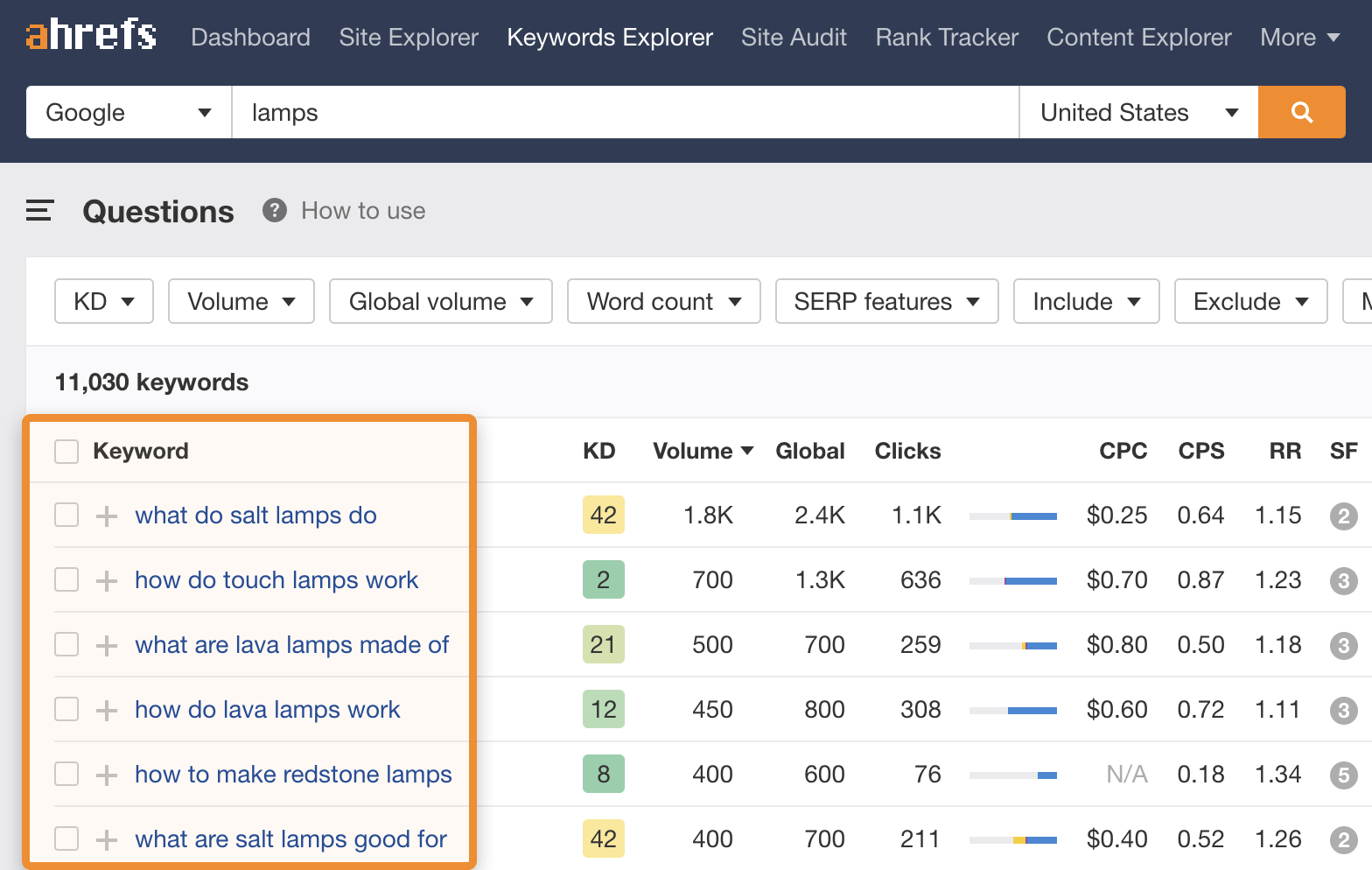
You can also use the Phrase match report to find queries containing your seed keyword sorted by monthly search volume. It doesn’t always make sense to target these keywords with a blog post or article: the format depends on search intent (see step 2 below).
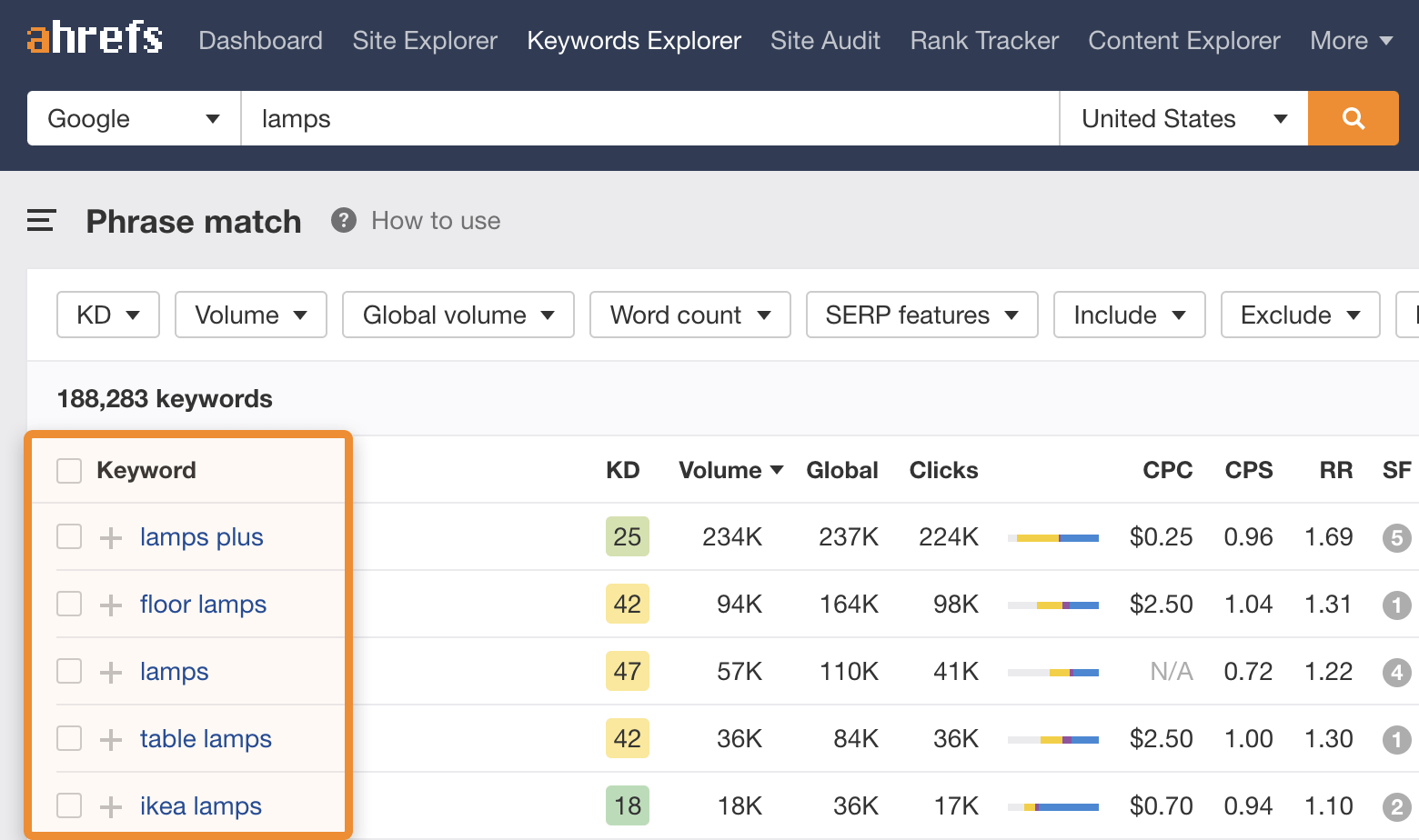
If your site is relatively new, a good starting point is to narrow down the list by filtering for keywords with low Keyword Difficulty (<30) scores and high monthly search volumes (1000+). These will usually be the easiest to rank for, while still having traffic potential.

For example, “best desk lamps” looks like a strong keyword with a good volume of monthly searches. And if we look at the SERP overview, the top-ranking page gets an estimated 7,000+ monthly visits from Google, so there is definite traffic potential.
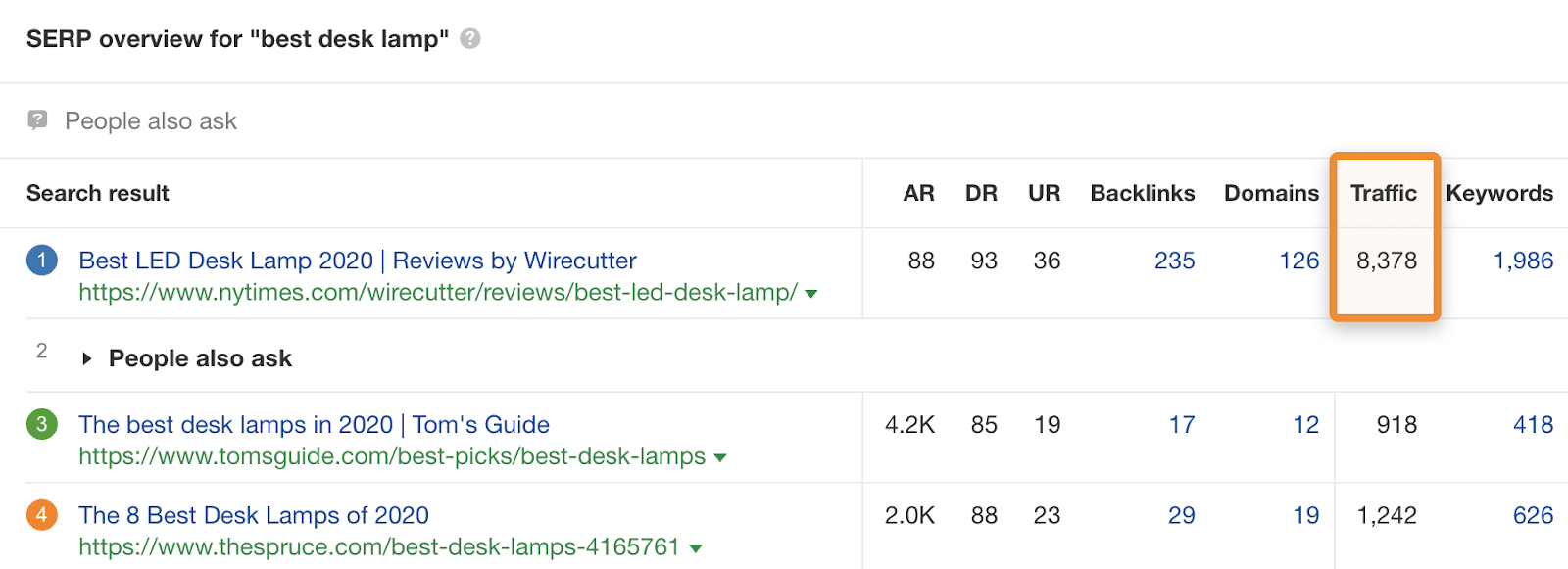
Estimated monthly US organic search traffic to the top-ranking page. Data from Ahrefs’ Keywords Explorer.
Following the same process for this guide, I started from “SEO” as my seed keyword and eventually found “SEO writing” in the Phrase match report. It became my chosen keyword as it has good search and traffic potential, is relevant to our target audience, and we’re not currently ranking for it.
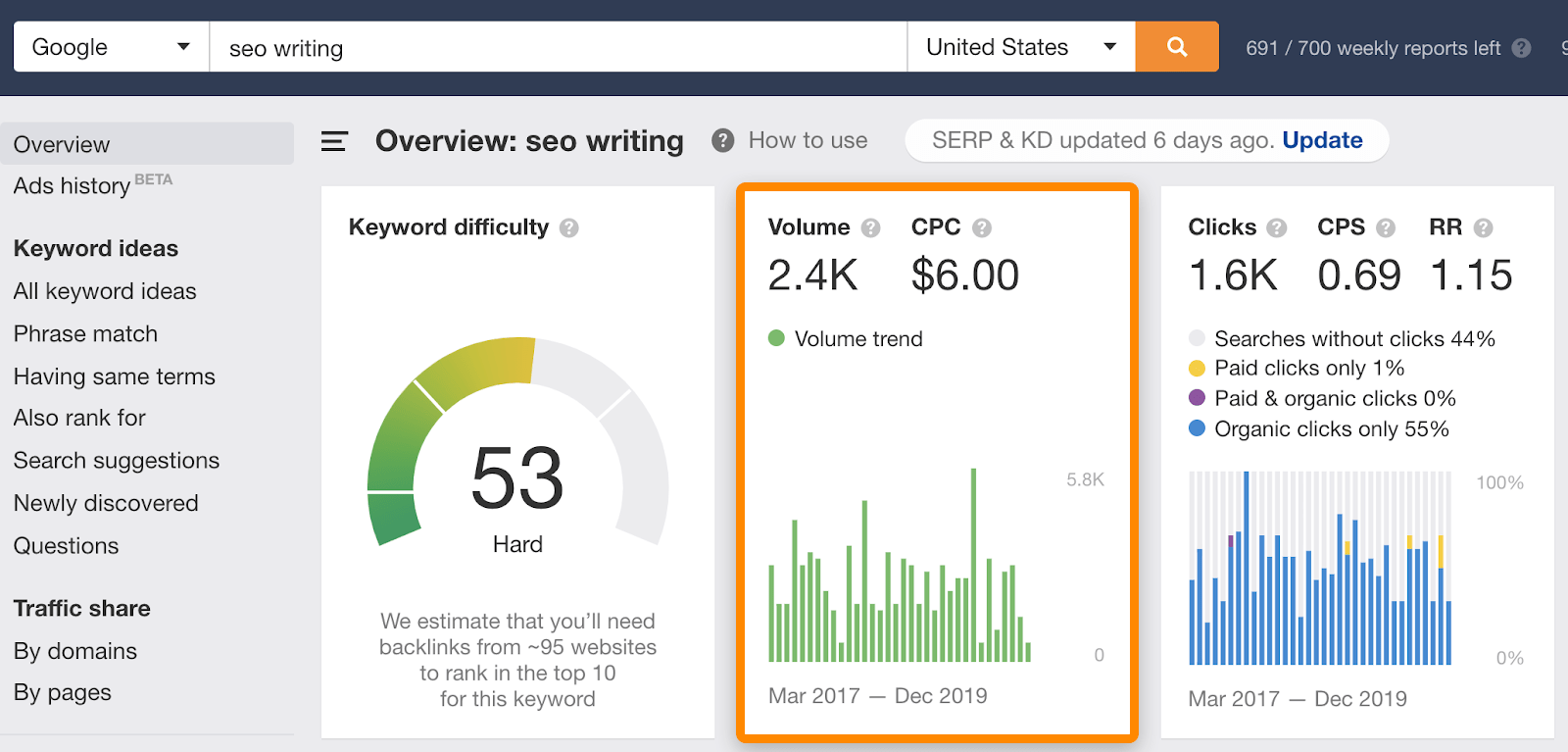
2. Determine search intent
Once you have a primary keyword with good traffic potential, you need to understand what people who search for it want. This is known as search intent, and if your content doesn’t match it, Google is unlikely to rank it high.
You can determine which pages best fit the intent behind a keyword by looking at the top-ranking results in the SERP and identifying what we call the 3 Cs of search intent: Content type, Content format, and Content angle.
Content-type
The type of content (e.g,. landing page, blog post/article, video, etc.) that ranks in the top positions tells you exactly what you need to create.
If you found your keyword in the Questions report, then the top results will almost always be blog posts, articles, or videos that give information to searchers in learning mode:
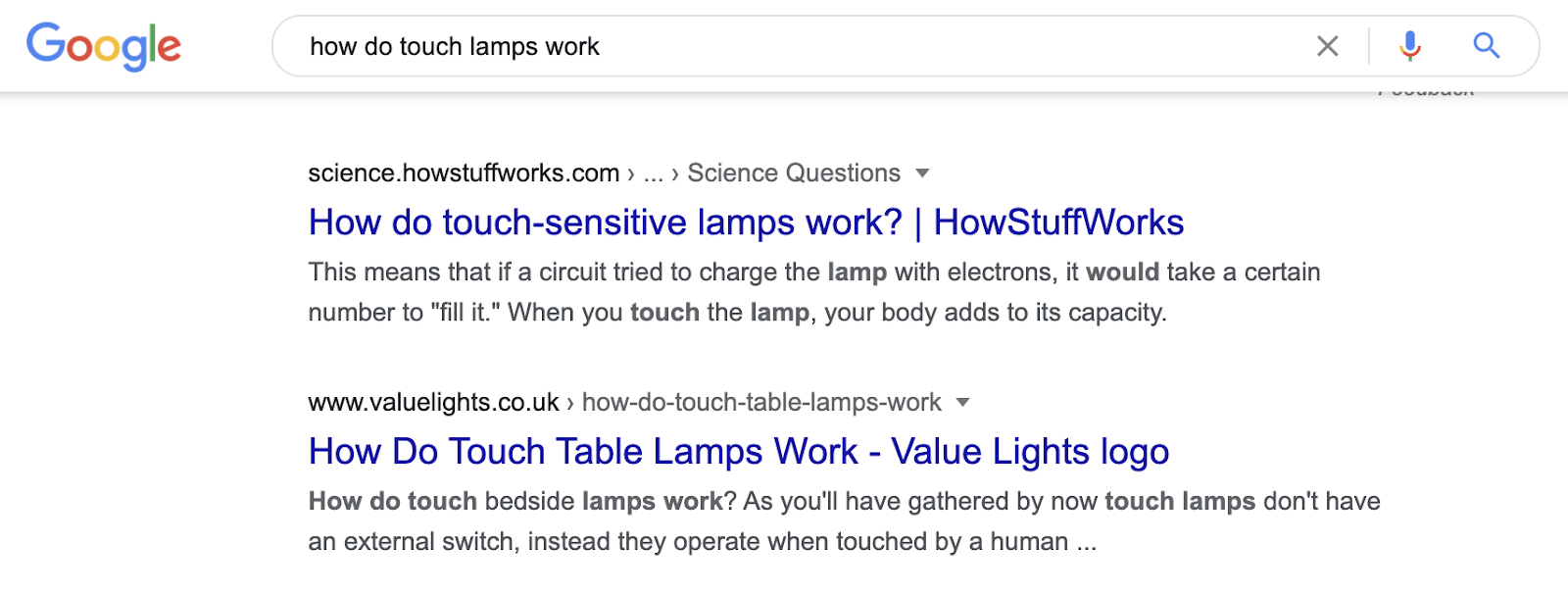
The top-ranking results for “how do touch lamps work”—both of which are blog posts.
However, if you used the Phrase match report, you might find keywords that don’t have informational intent, which means you won’t rank with a blog post. For example, the SERP suggests that people looking for “table lamps” are in buying mode, because the top-ranking results are ecommerce category pages.
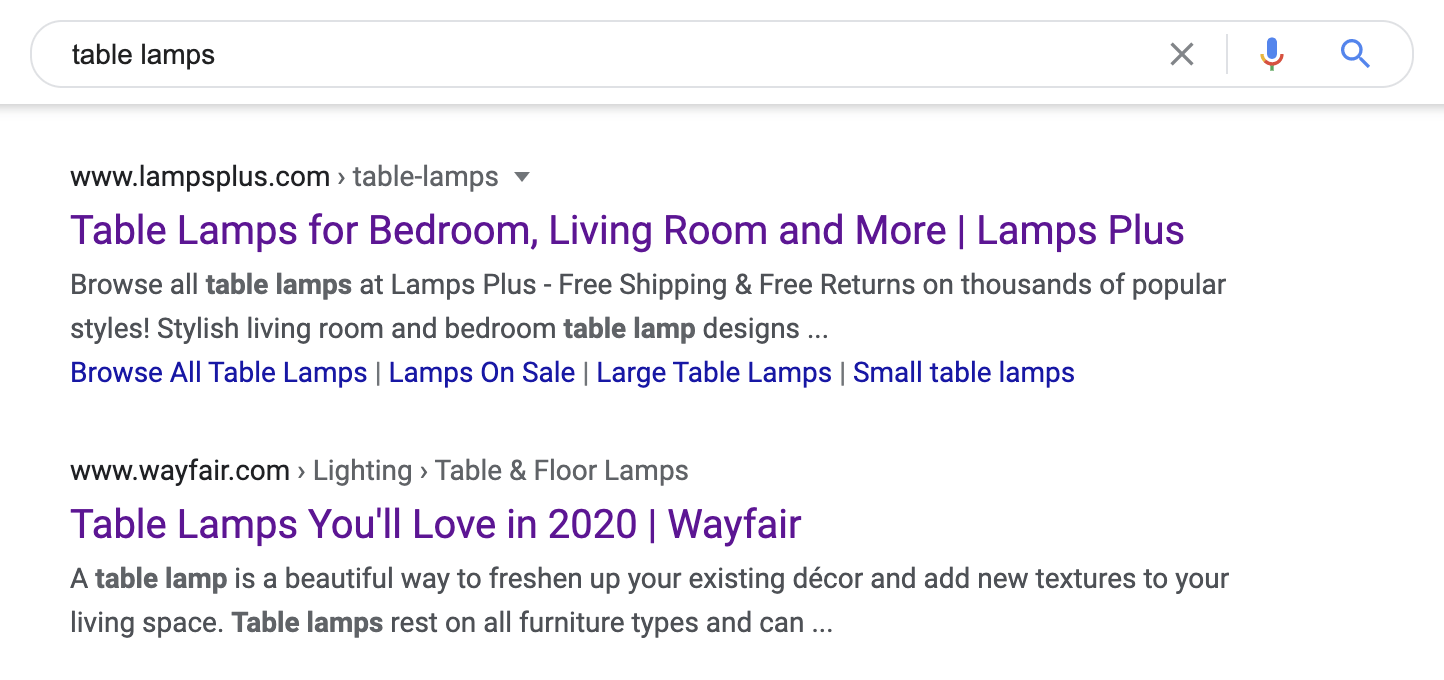
The top-ranking results for “table lamps”—all of which are ecommerce category pages.
Content format
The most common format (e.g., how-to, listicle, opinion piece) in the top positions will guide your decision on how to structure your content. For example, most of the results for “best desk lamp” are listicles, so that’s what you need to publish.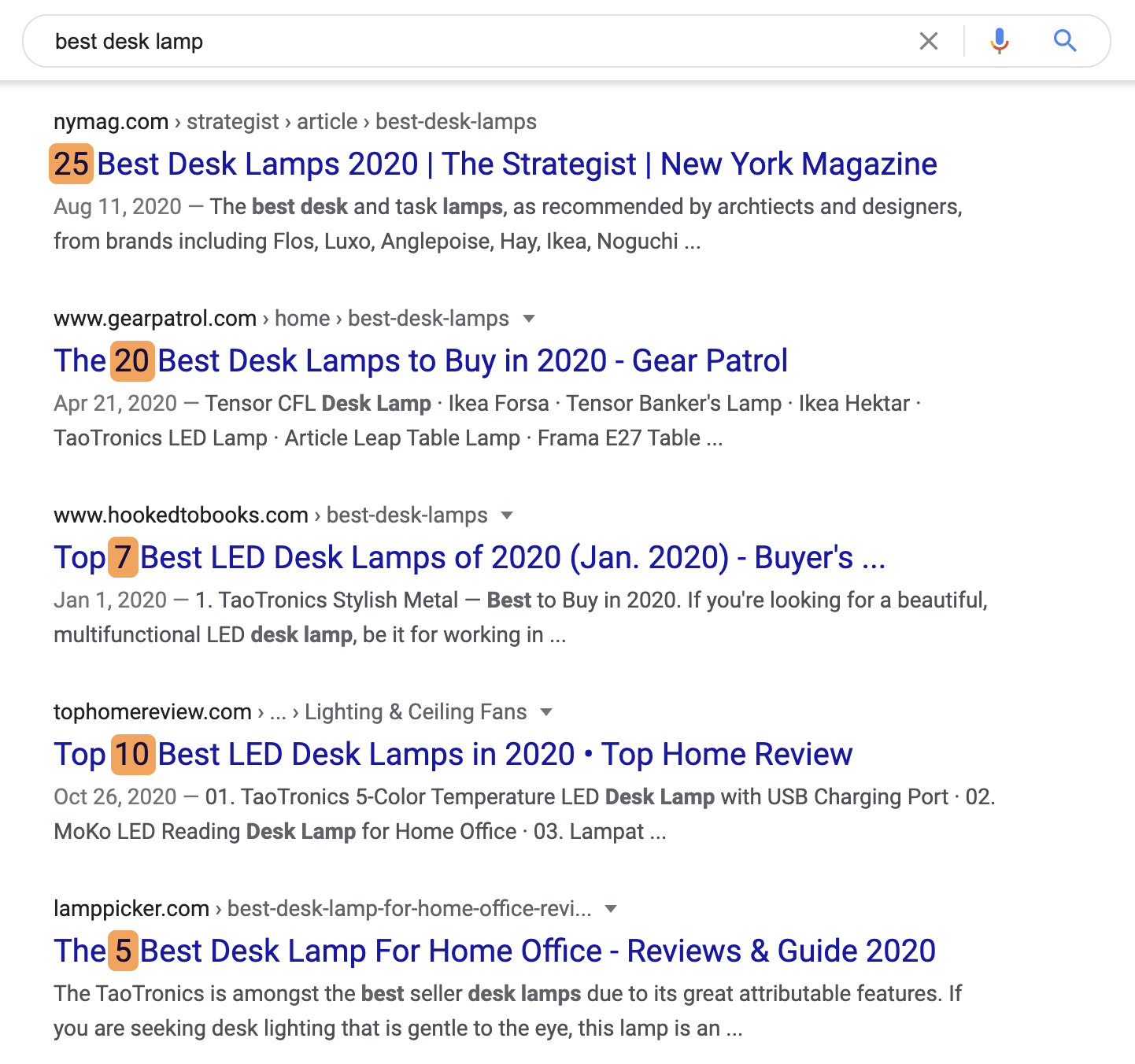
Content angle
Look for recurring themes in the top-ranking pages, and make a note of their unique perspective or opinion. For example, a common angle for “how to develop film” is that you can do it at home.

For this guide, the search intent behind “SEO writing” was pretty clear:
Content type → blog post/article
Content format → guide/how-to
Content angle → complete guides; techniques for beginners and/or writers who are new to SEO
To match search intent and get a better chance at ranking, I chose to make this a comprehensive SEO resource for writers instead of, say, doing a roundup of quotes or a listicle of top writing tips.
Search intent is a generally overlooked ranking factor that also helps you re-optimize existing content.
For example, our “What is SEO?” piece started off as a roundup of 40+ SEOs who answered the question and gave their own definition. When we re-looked at search intent after a few months, we realized nobody really wanted 40+ definitions: they mostly wanted to learn, and this gap between their intent and our content was probably holding the piece back.
So we rewrote the page to bring it more in line with search intent, and traffic shot up pretty much overnight.
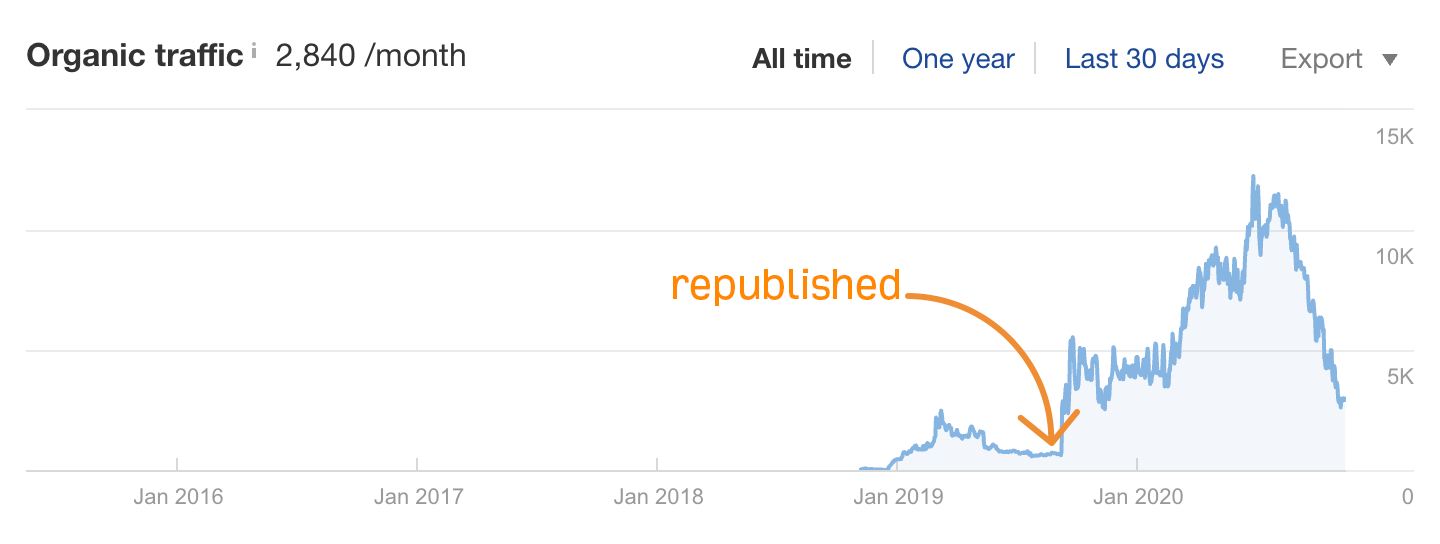

3. Determine the subtopics you need to cover
At this point, you have a strong primary keyword and know the type, format, and angle of the content you’re going to write.
Keep your researcher hat on a little longer: you’re now going to investigate the top-ranking pages (your ‘competitors’ for this keyword) and the SERP to determine the subtopics you need to cover.
Use a doc, text editor, or spreadsheet to note all the following information down.
Method 1: Analyze your competitors’ content and headings
Having a list of headings helps you understand a competitor’s content at a glance and get a sense of what subtopics you may need to cover in your article. Plus, you can get a few ideas about how to make yours better, more useful, and more original.
Visit the top-ranking pages and look at their outlines (i.e., headings). You can use Ahrefs’ free SEO toolbar to quickly visualize headings on any page. Click on the checklist icon to open the on-data page report, scroll down until you see a list of headings, and make a note of any common topics.
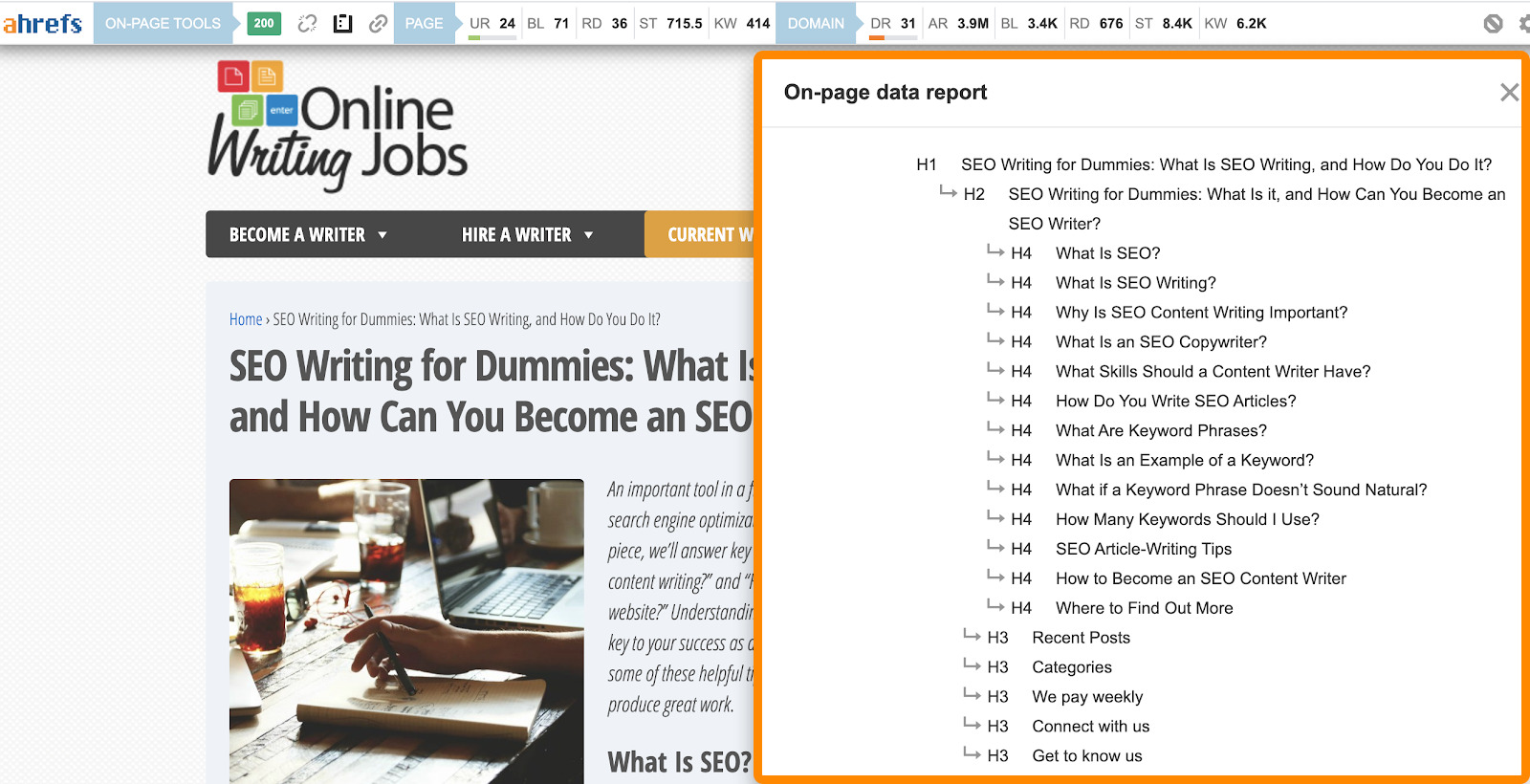
For this guide, most of the top-ranking articles included a “What is SEO writing?” subheading, which told me I need to include the definition as it seems to be what searchers are looking for.
Method 2: Check PAA boxes
Go back to Google and search for your primary keyword. The People also ask (PAA) feature can give you an idea of what may be on people’s mind as they run their search:

You don’t have to answer every single question you see, but you might get a better sense of what people expect to find on your page. In the example above, it looks like people are looking for fresh content (“2020”).
Method 3: Find what your competitors are ranking for
Knowing what other keywords your competitor pages are ranking for helps you make sure you cover the topic without leaving anything important out.
You can find keyword ranking data by pasting the top-ranking URLs into Ahrefs’ Content Gap tool and clicking ‘Show keywords’.


Look for commonalities between the top-ranking pages. Here, you’re not looking for keywords to just ‘sprinkle’ into your content, but for subtopics that may need to be included in your outline.
4. Create an outline
If you followed the steps above, you will have:
Now it’s time to create an outline. Open a new Google Doc (or whatever text editor you use) and write a working title at the top of the page. This helps you clarify and keep the primary angle in mind when writing.
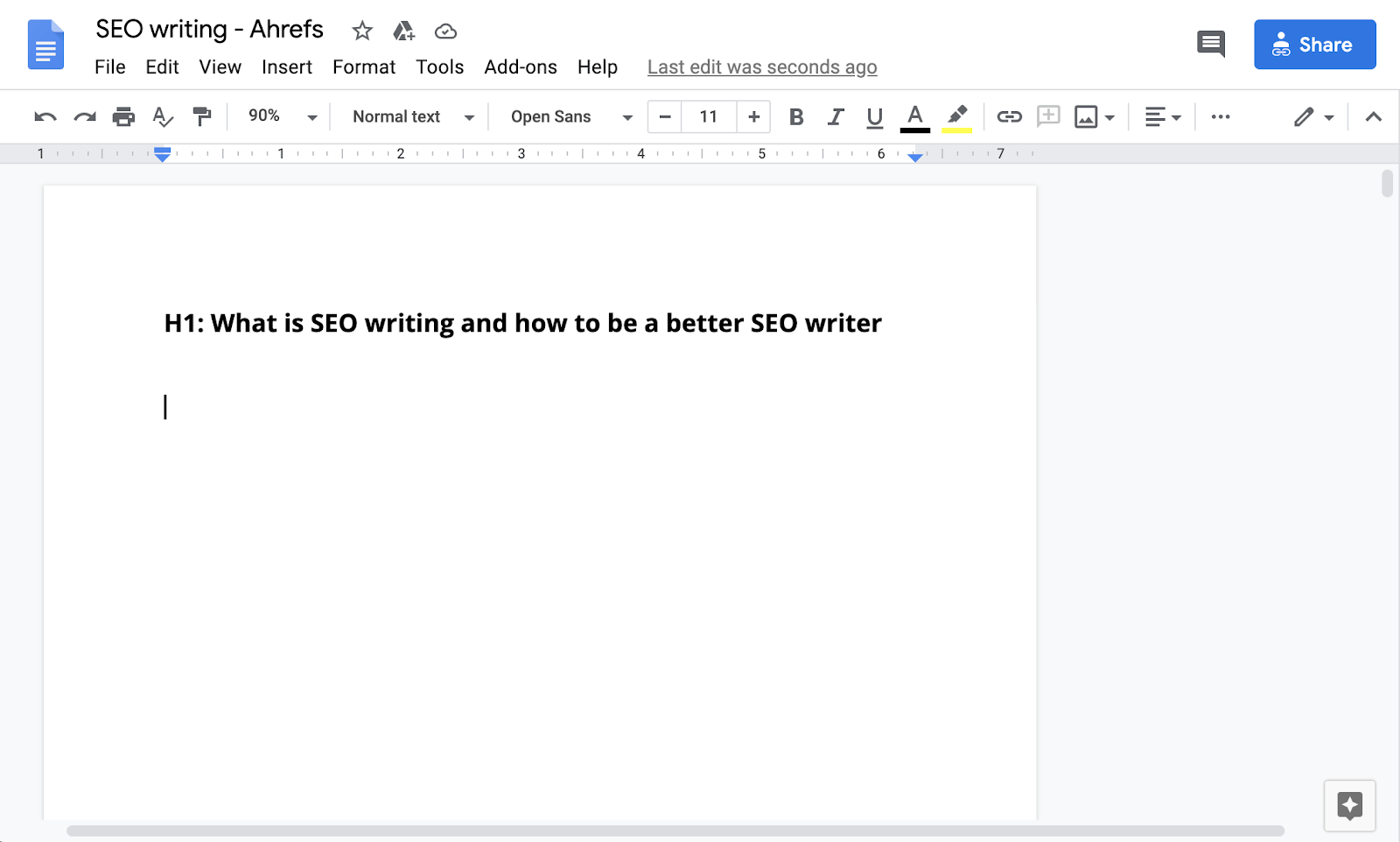
Next, write out a logical heading structure using an ‘inverted pyramid’ approach. Start from the most substantial and important information about the topic, and keep building your arguments and expanding logically throughout the article.

In my case, I started from a definition of SEO writing, explained why it’s important, then proceeded down into a linear set of how-to steps. The section about tips, which you’ll read shortly, is useful but not crucial—a ‘nice to know’ that comes at the bottom of the pyramid.
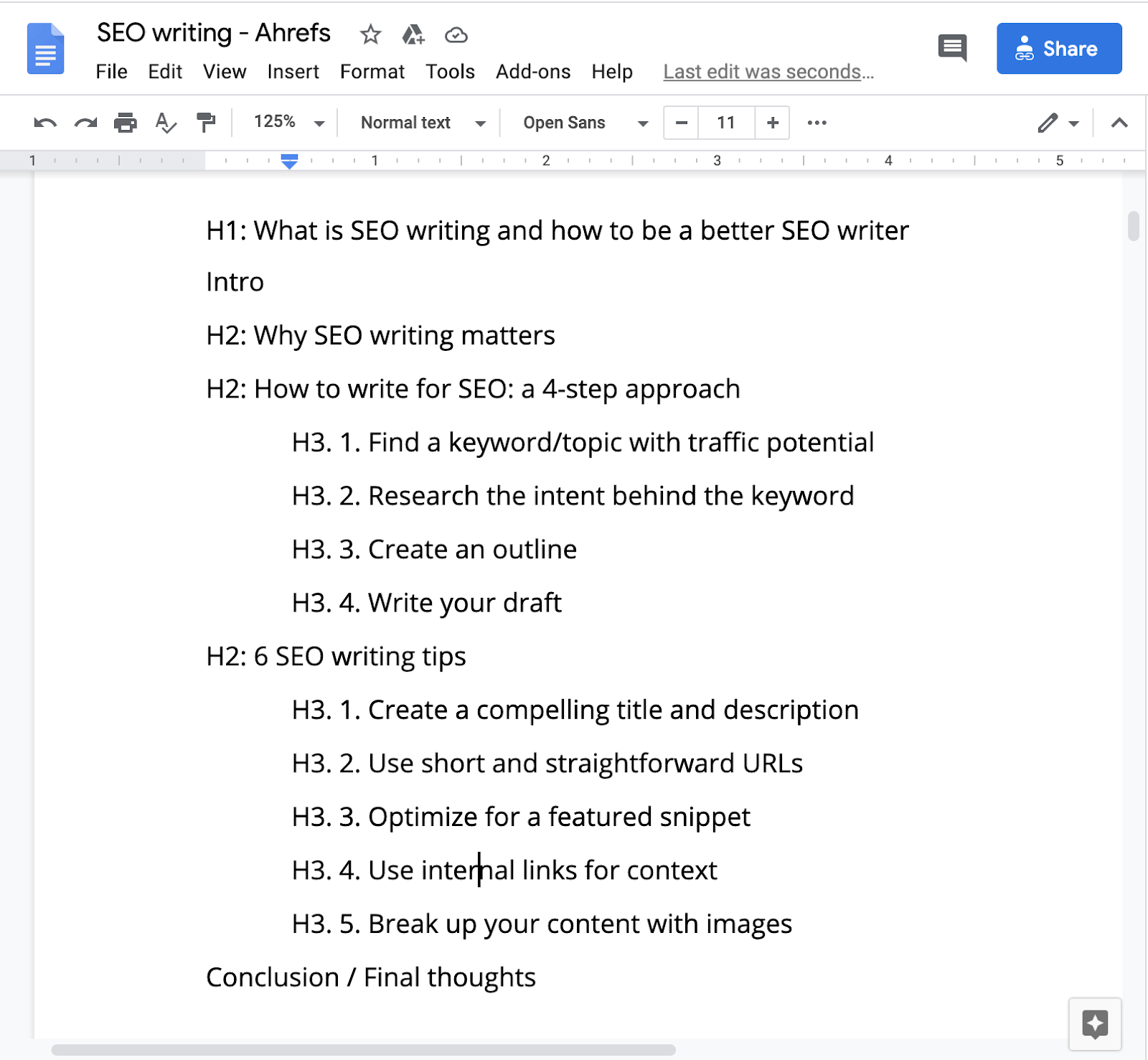

5. Write the draft
You’ve finally reached the writing stage, where you are going to turn the outline into a fully formed draft. As a content writer, you already know what to do—but here are a few useful principles to follow:
Write naturally and with your audience in mind
By the time you get to writing, most of the key SEO elements you need are already in place, so you can focus on writing naturally.
Use a conversational tone, avoiding convoluted sentences and unnecessary ‘fluff’. Tools such as Hemingway help you sharpen and simplify your work—although they won’t detect technical or specialized language, so you’ll have to have to use your judgment.

An example of technical language that Hemingway considers hard to read.
Remember to keep your audience in mind. For example, if you’re aiming a piece at beginners, think about what knowledge they already have versus what you need to explain. It may help to picture a real person and write your draft for them.
Speaking of which:
Use your audience’s vocabulary
If you’re not an expert in the industry you’re writing for, you might choose generic words or phrases that don’t resonate with readers and make them trust you less. For example, if you’re not into mountaineering, you may not know that “getting to the top of a mountain” is called “summiting”—but a discerning audience definitely does.
When you lack first-hand knowledge, you can build your vocabulary by researching existing content:
Add a unique element or spin
An SEO outline is a bit like a coloring book: you have the general contours, but how you fill them in is entirely up to you.
Your research pays off here, too, because knowing what your competitors did can help you come up with something unique. For example, most of the content that ranks for “SEO writing” uses generic examples: in contrast, I decided to take a ‘meta’ approach and show how a real piece evolves from initial idea to publication.
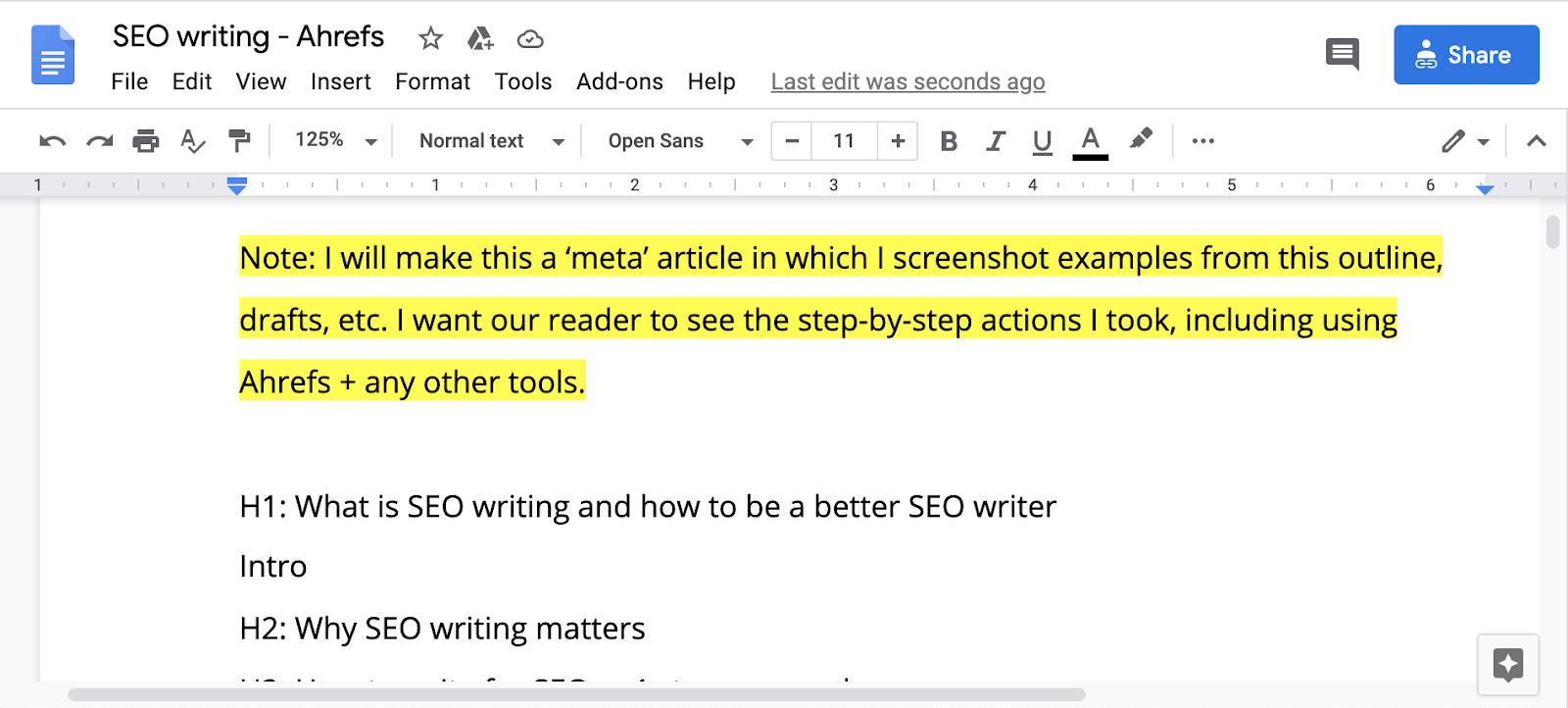
Follow the outline, but be ready to alter it
You will probably find that an SEO outline that makes sense in the abstract needs tweaking as you write your first draft. That’s perfectly fine.
For example, my original outline had 4 main steps. However, as I started fleshing it out, it became obvious that one of the steps could be split into two: so I made a note in the outline and changed the draft accordingly.

SEO writing doesn’t end with what you see on the page. If you want your content to have the best shot at ranking and getting traffic, follow these additional tips to optimize things behind the scenes.
- Create a compelling title
- Use short and straightforward URLs
- Optimize for featured snippets
- Use internal links for context
- Strengthen your content with images
1. Create a compelling title
Your title tag is the most visible element in the SERP, and you won’t get any traffic (or a good SERP click-through-rate) if people don’t think it’s worth clicking.
Look at the titles of top-ranking pages and write one that could win the click from the competition. Use your primary keyword and communicate why your page matches search intent and how it offers value. Where applicable, also use:
Writing a good SEO title is not about clickbait: you don’t want visitors bouncing back to the SERPs if your content doesn’t deliver, so be genuine.
Tip: use a SERP preview tool to see what your title will look like before you hit publish.
2. Use short and straightforward URLs
Create an SEO-friendly URL by keeping it short and simple. Your primary keyword is usually sufficient. Short URLs are easier to read, while long ones get cut off in the SERP and may lose context.
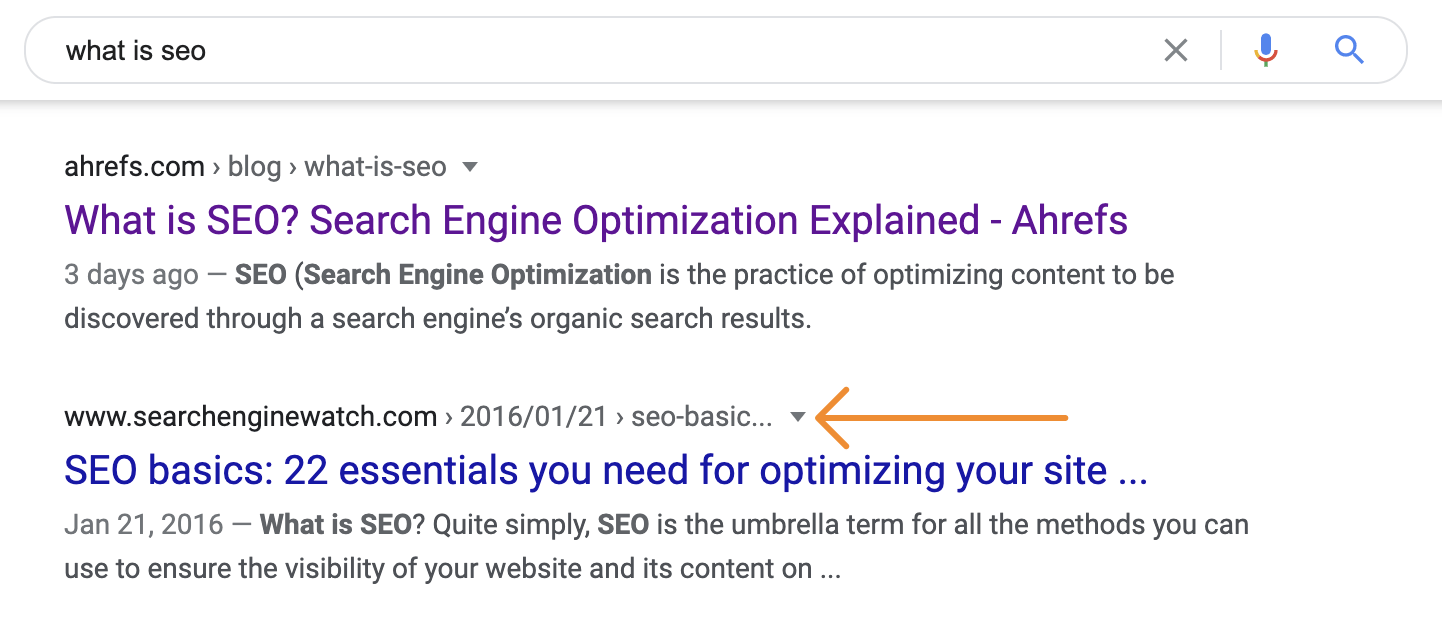
Avoid using numbers and dates in the URL, as they are hard to change if you update your content in the future.
3. Optimize for featured snippets
Featured snippets are short summaries that appear at the top of Google’s organic search results. Lots of searches have featured snippets, and getting one gives your work immediate visibility in the SERP.
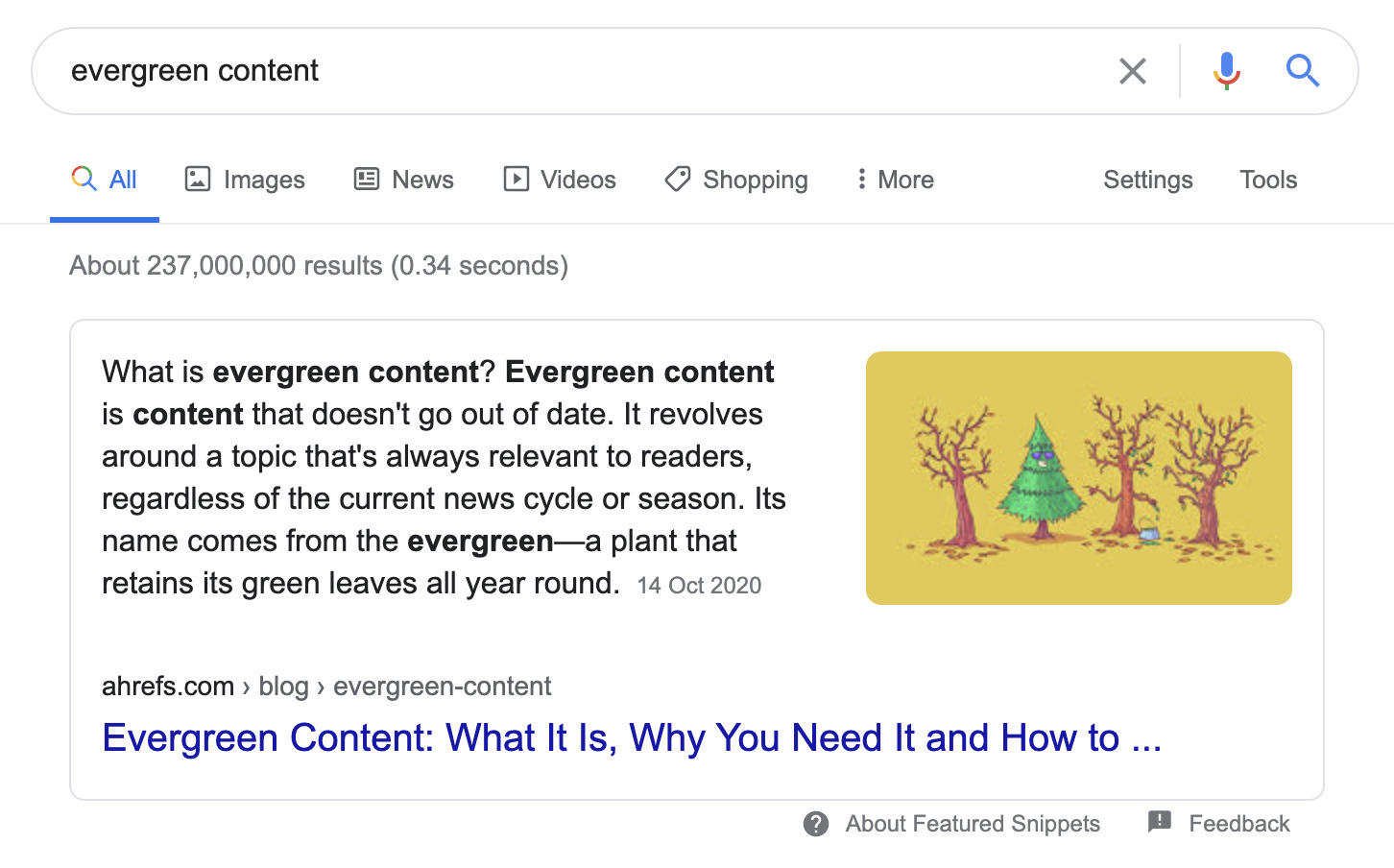
To optimize for your primary keyword snippet, look at the SERP to understand the format of the existing result. For example, you may see that the featured snippet is a list:
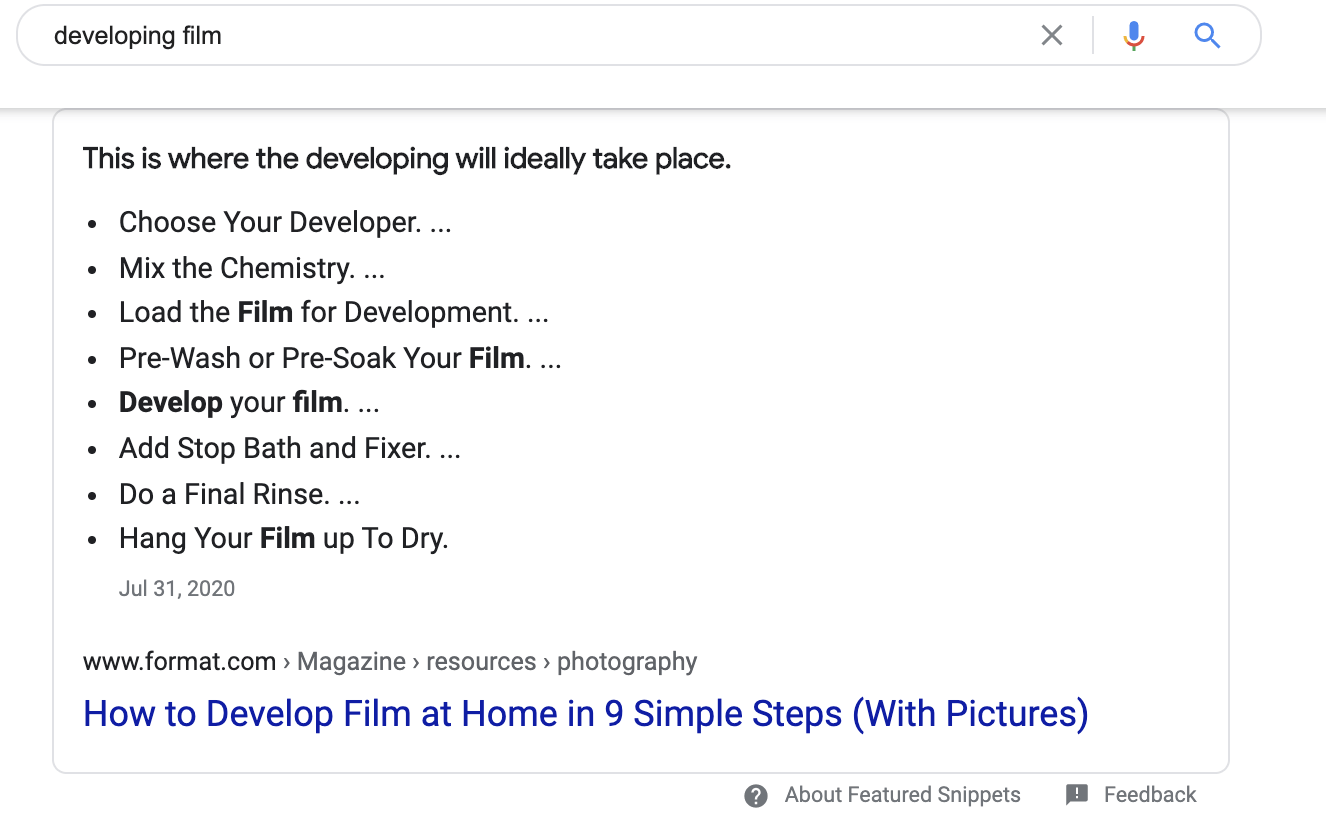
A list snippet tends to be pulled from your headings, so if you analyzed search intent correctly you should have optimized for these snippets by default anyway—just by structuring your article logically.
In other cases, you may see a paragraph snippet:

Here, you’re aiming to answer the query succinctly and in a straightforward way.
4. Use internal links for context
You can’t cover everything in one article, so use internal links to signpost people to additional resources that will give more context. And since Google uses internal links to help discover new content, they’re great for SEO too.
For example, there are a lot of useful SEO copywriting formulas I could have covered in this guide, but that would be a deviation from the main point. Instead, I can direct you to companion resources on SEO copywriting and SEO content if you want to read more.
5. Strengthen your content with images
An SEO writer works primarily with words, but images help your readers follow along and can give your content additional depth. Nobody enjoys a wall of text (unless they’re reading a novel): use images strategically to create breaks and visualize your points.

Bonus point: using images like the ones you’ve seen so far also lets your readers know that you’re ‘real’ and know what you’re talking about, especially when you are guiding them through specific actions or showcasing your thought process.
Final thoughts
If there is ONE thing you should take away from this guide, it’s this: SEO writing is not about stuffing keywords into a piece to please search engines or misleading people into clicking on a specific result. It’s about writing good content that really serves the audience which, in turn, helps you rank and grow traffic.
Got questions?


No comments:
Post a Comment